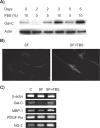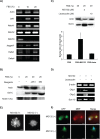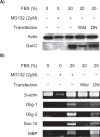Involvement of Notch1 inhibition in serum-stimulated glia and oligodendrocyte differentiation from human mesenchymal stem cells
- PMID: 24198522
- PMCID: PMC3781741
- DOI: 10.2147/SCCAA.S14388
Involvement of Notch1 inhibition in serum-stimulated glia and oligodendrocyte differentiation from human mesenchymal stem cells
Abstract
The use of in vitro oligodendrocyte differentiation for transplantation of stem cells to treat demyelinating diseases is an important consideration. In this study, we investigated the effects of serum on glia and oligodendrocyte differentiation from human mesenchymal stem cells (KP-hMSCs). We found that serum deprivation resulted in a reversible downregulation of glial- and oligodendrocyte-specific markers. Serum stimulated expression of oligodendrocyte markers, such as galactocerebroside, as well as Notch1 and JAK1 transcripts. Inhibition of Notch1 activation by the Notch inhibitor, MG132, led to enhanced expression of a serum-stimulated oligodendrocyte marker. This marker was undetectable in serum-deprived KP-hMSCs treated with MG132, suggesting that inhibition of Notch1 function is additive to serum-stimulated oligodendrocyte differentiation. Furthermore, a dominant-negative mutant RBP-J protein also inhibited Notch1 function and led to upregulation of oligodendrocyte-specific markers. Our results demonstrate that serum-stimulated oligodendrocyte differentiation is enhanced by the inhibition of Notch1-associated functions.
Keywords: Notch1 signaling; glia and oligodendrocyte differentiation; mesenchymal stem cells; serum deprivation.
Figures




Similar articles
-
Bone marrow mesenchymal stem cells promote remyelination in spinal cord by driving oligodendrocyte progenitor cell differentiation via TNFα/RelB-Hes1 pathway: a rat model study of 2,5-hexanedione-induced neurotoxicity.Stem Cell Res Ther. 2021 Aug 4;12(1):436. doi: 10.1186/s13287-021-02518-z. Stem Cell Res Ther. 2021. PMID: 34348774 Free PMC article.
-
The DLC-1 tumor suppressor is involved in regulating immunomodulation of human mesenchymal stromal /stem cells through interacting with the Notch1 protein.BMC Cancer. 2020 Nov 4;20(1):1064. doi: 10.1186/s12885-020-07542-5. BMC Cancer. 2020. PMID: 33148199 Free PMC article.
-
[Expression changes of Notch-related genes during the differentiation of human mesenchymal stem cells into neurons].Sheng Li Xue Bao. 2007 Jun 25;59(3):267-72. Sheng Li Xue Bao. 2007. PMID: 17579779 Chinese.
-
Inhibition of Notch1 signaling promotes neuronal differentiation and improves functional recovery in spinal cord injury through suppressing the activation of Ras homolog family member A.J Neurochem. 2019 Sep;150(6):709-722. doi: 10.1111/jnc.14833. Epub 2019 Aug 26. J Neurochem. 2019. PMID: 31339573
-
Zinc-induced downregulation of Notch signaling is associated with cytoplasmic retention of Notch1-IC and RBP-Jk via PI3k-Akt signaling pathway.Cancer Lett. 2007 Sep 18;255(1):117-26. doi: 10.1016/j.canlet.2007.04.002. Epub 2007 May 21. Cancer Lett. 2007. PMID: 17513037
References
-
- Bruck W. The pathology of multiple sclerosis is the result of focal inflammatory demyelination with axonal damage. J Neurol. 2005;252(Suppl 5):v3–v9. - PubMed
-
- Lubetzki C, Williams A, Stankoff B. Promoting repair in multiple sclerosis: Problems and prospects. Curr Opin Neurol. 2005;18:237–244. - PubMed
-
- Lublin F. History of modern multiple sclerosis therapy. J Neurol. 2005;252(Suppl 3):iii3–iii9. - PubMed
-
- Keirstead HS. Stem cells for the treatment of myelin loss. Trends Neurosci. 2005;28:677–683. - PubMed
-
- Pittenger MF, Mackay AM, Beck SC, et al. Multilineage potential of adult human mesenchymal stem cells. Science. 1999;284:143–147. - PubMed
LinkOut - more resources
Full Text Sources
Research Materials
Miscellaneous

